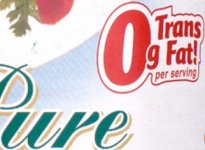jlw
Rangefinder camera pedant
Much has been made of the fact that the Leica M8 doesn't have an anti-aliasing filter in front of its sensor, the rationale being to provide sharper, more detailed pictures.
This claim may have made some people wonder why DSLR makers use an anti-aliasing filter at all. After all, doesn't everyone want sharp, detailed pictures?
I happened to run into a situation at work today that illustrates why some kind of anti-aliasing is needed, so thought I'd share it with the group.
I was photographing a bottle with a printed label; on the label, the "screening" (dot pattern) of the printing is fairly coarse. I was using a medium-format camera with a digital back (Fuji GX-680 III and MegaVision S3 for you gearheads) and this back does not incorporate a hardware anti-aliasing filter. (This is an old back, but most current medium-format digital backs don't use an anti-aliasing filter either.)
The first attachment shows a section of the image I captured. Note the magenta and green artifacts in the screened area to the left of the red zero. These colors are the result of aliasing: the screen pattern of the printing was interacting with the pixel pattern of the imager.
Just as Leica is doing with the M8, MegaVision's strategy for dealing with aliasing was to incorporate anti-aliasing routines in software. In MegaVision's case, there are three different filter routines (light, medium and heavy) from which to choose. Since the software runs on an old computer, it takes a couple of minutes to anti-alias each image! (Normally what you do is capture a bunch of raw files, then go to lunch while running a batch utility to anti-alias them and render them out as 16-bit TIFFs.)
The second attachment shows the result of this procedure. Much better, right? I'm sure Leica's in-camera software won't take as long as MegaVision's "outboard" software to apply anti-aliasing, but it will be interesting to see how they've balanced the tradeoff between fine detail and alias reduction, and how well their choice works out in practice.
This claim may have made some people wonder why DSLR makers use an anti-aliasing filter at all. After all, doesn't everyone want sharp, detailed pictures?
I happened to run into a situation at work today that illustrates why some kind of anti-aliasing is needed, so thought I'd share it with the group.
I was photographing a bottle with a printed label; on the label, the "screening" (dot pattern) of the printing is fairly coarse. I was using a medium-format camera with a digital back (Fuji GX-680 III and MegaVision S3 for you gearheads) and this back does not incorporate a hardware anti-aliasing filter. (This is an old back, but most current medium-format digital backs don't use an anti-aliasing filter either.)
The first attachment shows a section of the image I captured. Note the magenta and green artifacts in the screened area to the left of the red zero. These colors are the result of aliasing: the screen pattern of the printing was interacting with the pixel pattern of the imager.
Just as Leica is doing with the M8, MegaVision's strategy for dealing with aliasing was to incorporate anti-aliasing routines in software. In MegaVision's case, there are three different filter routines (light, medium and heavy) from which to choose. Since the software runs on an old computer, it takes a couple of minutes to anti-alias each image! (Normally what you do is capture a bunch of raw files, then go to lunch while running a batch utility to anti-alias them and render them out as 16-bit TIFFs.)
The second attachment shows the result of this procedure. Much better, right? I'm sure Leica's in-camera software won't take as long as MegaVision's "outboard" software to apply anti-aliasing, but it will be interesting to see how they've balanced the tradeoff between fine detail and alias reduction, and how well their choice works out in practice.



